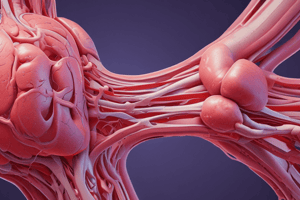Podcast
Questions and Answers
A patient with venous insufficiency develops a wound on their lower leg. What is the MOST important nursing intervention to prevent a common complication?
A patient with venous insufficiency develops a wound on their lower leg. What is the MOST important nursing intervention to prevent a common complication?
- Applying sterile dressings to the wound every shift.
- Elevating the patient's legs and applying compression. (correct)
- Limiting the patient's mobility to reduce pressure on the wound.
- Administering prophylactic antibiotics as prescribed.
A patient with a history of venous insufficiency is being discharged. Which statement indicates a NEED for further teaching?
A patient with a history of venous insufficiency is being discharged. Which statement indicates a NEED for further teaching?
- "I should avoid wearing tight clothing around my legs."
- "I should elevate my legs when sitting for extended periods."
- "I should sit for long periods with my legs crossed to improve comfort." (correct)
- "I should apply my compression stockings before getting out of bed."
Which assessment finding is MOST indicative of venous stasis dermatitis in a patient with chronic venous insufficiency?
Which assessment finding is MOST indicative of venous stasis dermatitis in a patient with chronic venous insufficiency?
- Shiny, taut skin with decreased hair growth.
- Thick, hardened skin with a 'woody' appearance on the upper legs.
- Pale, cool extremities with diminished pulses.
- Brown discoloration of the skin around the ankles. (correct)
Which patient is MOST at risk for developing venous insufficiency?
Which patient is MOST at risk for developing venous insufficiency?
A patient with venous insufficiency is prescribed compression stockings. What should the nurse emphasize when educating the patient about their use?
A patient with venous insufficiency is prescribed compression stockings. What should the nurse emphasize when educating the patient about their use?
Flashcards
Venous Insufficiency
Venous Insufficiency
Veins in the lower extremities don't effectively transport blood back to the heart.
Risk Factors for Venous Insufficiency
Risk Factors for Venous Insufficiency
Obesity, immobility, pregnancy, and a history of deep vein thrombosis (DVTs).
Signs and Symptoms of Venous Insufficiency
Signs and Symptoms of Venous Insufficiency
Edema and brown discoloration of the skin (stasis dermatitis), especially around the ankles.
Nursing Care for Venous Insufficiency
Nursing Care for Venous Insufficiency
Signup and view all the flashcards
Patient Teaching for Venous Insufficiency
Patient Teaching for Venous Insufficiency
Signup and view all the flashcards
Study Notes
- Venous insufficiency occurs when veins in the lower extremities cannot effectively transport blood back to the heart due to valve issues.
Risk Factors
- Obesity
- Immobility
- Pregnancy
- History of DVTs
Signs and Symptoms
- Edema
- Brown skin discoloration in lower extremities (stasis dermatitis)
- Heavily draining wounds around the ankles
Nursing Care
- Elevate legs to promote blood return to the heart.
- Apply compression stockings or wraps as prescribed, ideally in the morning when swelling is reduced.
- Monitor for complications like cellulitis, which can result from infected venous stasis ulcers.
Patient Teaching
- Avoid prolonged sitting or standing.
- Change positions frequently and walk around regularly.
- Avoid crossing legs or wearing restrictive clothing.
- Reinforce the importance of wearing properly fitted compression stockings.
- Apply compression stockings in the morning before getting out of bed.
Studying That Suits You
Use AI to generate personalized quizzes and flashcards to suit your learning preferences.



